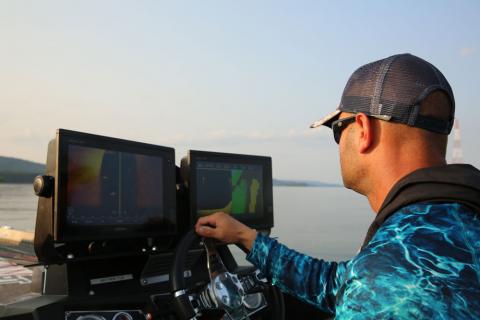Todd Amenrud | Originally published in GameKeepers: Farming for Wildlife Magazine. To subscribe, click here.
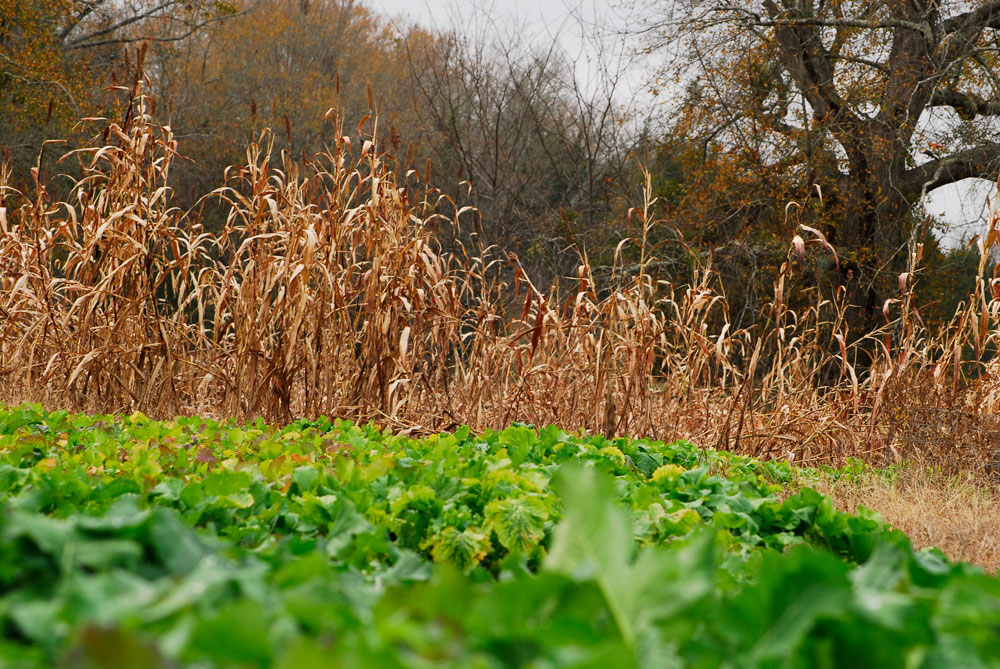
When it comes to hunting whitetails, much has been written about tree stand placement, playing the wind and thermal and other major points; however, oftentimes it can be tiny details that mean the difference between “antlers on the ground” and a “white, hairy flag waving goodbye.” Your arrow glancing off of a tiny twig, having your tree stand squeak at the wrong time, bumping deer on your approach or accidentally transferring a molecular whiff of foreign smell to some nearby foliage can be all it takes for your plan to go awry. Implementation of a few key details can improve your consistency significantly.
A buck doesn’t even need to see you, if a mature buck senses an intrusion or feels like he’s being hunted, they will not tolerate a great deal before changing something to avoid making contact with you. There are a few details some hunters feel aren’t important, like trimming shooting lanes, placing a bow-holder in the right place to keep movement to a minimum, inserting background cover to avoid being silhouetted, taking extra steps to camouflage a blind, or raking leaves and pruning brush from your approach trail to make it as quiet as possible, but these fine points can mean the difference between fried liver and a full quiver.
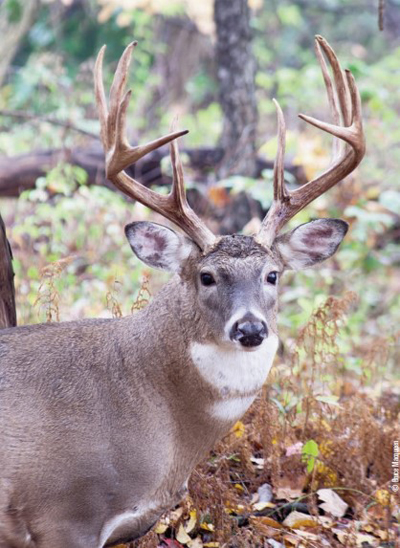
that spot. A molecular trace of human scent on a branch
you brushed against or a tree-step screwed in with a bare
hand can be all it takes for them to associate danger to the
site and all your work to go for not.
If it’s in the way, it can ruin your day!
Presuming you’ve chosen the right location, there are a number of details you should take into consideration when putting the finishing touches on your ambush site. Obviously a tree stand will be different from a ground blind, but one detail you should always observe is trimming shooting lanes/windows. What good is it if a buck passes by within range but you can’t get a clear shot? As they say, “close only counts in horseshoes and hand-grenades.”
“Clean” is the key word when it comes to trimming shooting lanes. This word has significance for both sight and smell. You don’t want it to seem like there’s been a big disturbance at the site and you want to keep “scent transfer” to an absolute minimum. Any whitetail, let alone a mature buck, can tell when its area has been disturbed – more so by scent than by sight, but when I trim shooting lanes I try to pile any branches off of the trails and try to make it look as natural as possible. A main point is to always wear clean gloves treated with Scent Killer to reduce scent transfer.
A device I have dubbed my “extend-opruner” (most refer to it as a “polepruner”) works well to trim branches as high as twenty feet off the ground or more. It has a saw and pruner-clipper with a handle that extends fourteen feet, so combined with a person’s height, with arms raised you can reach over twenty feet or more to snip twigs that otherwise could derail your destiny with a monster buck. There are other pole saws on the market that can extend over twenty-five feet, so reach shouldn’t be a problem. There are also a number of electric and gas powered pole-trimmers available to make the cutting easier.
Because a tree stand will often be placed above “pruner-height,” I will bring the pruner up the tree so twigs can be snipped that can’t be reached from the ground. Whenever you’re in a tree stand, please, make sure you’re wearing a safety harness, but especially so when you’re doing work like snipping shooting lanes/windows. Eye protection should also be worn at all times to guard against a twig in the eye or sawdust falling while working on a branch above your head.
Whenever you enter their turf you should use the same system of scent elimination as if you were hunting - when setting up your tree stand, ground-blind or clearing branches for shooting opportunities, it’s always important to reduce foreign odors and scent transfer. I use the Scent Killer system and when preparing my clothing, Scent Killer Gold is especially important to me. I wash my clothing in Scent Killer Clothing Wash and when it’s dry I treat it with Scent Killer Gold spray. It prevents smells from creating a gas. No gas, no smell.
Scent-transfer, or smells you may be leaving behind, can ruin your chances just as fast as if they detect you directly. You don’t want the animal to know you’re presently there, or that you’ve been there at all. Anytime you touch anything it’s like you’re “pushing” your smell into the object. I always wear clean clothing, including gloves that have been washed in Scent Killer Clothing Wash and treated with Scent Killer Gold spray. Sometimes I will even wear elbow-length trapper’s gloves to be extremely careful of preventing scent-transfer. Even screwing a tree step with your bare hand can be all it takes to blow it on a mature buck.
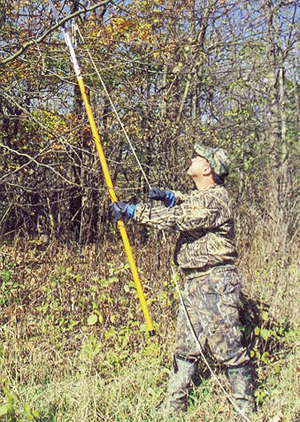
creating clean shooting opportunities. Most
styles can snip arrow-deflecting branches at
heights of twenty feet or more.
Trimming shooting lanes with a friend can work well. This way one can sit in the blind or tree stand and instruct exactly which branches need to be trimmed. You don’t need a perfectly cleared strip 10 feet wide from the base of your tree and forty yards out. Often all you need is a “window” to a specific trail or spot. Two details are important here; one, you don’t want to disturb the area so much that a mature buck knows there has been an intrusion. And two, the more brush you trim down, the less cover there is to keep you concealed. Any cover between you and a buck is valuable for keeping you obscured - even if it’s just a few leaves that add depth and a three dimensional effect.
Some hunters think, “I’m not going to hunt the site for three weeks, so I’m not worried about fouling the site with foreign scent when placing the tree stand (or ground blind) because it has weeks to diminish.” These hunters don’t understand that if the buck you’re after shows up five minutes, five hours or five days later, and detects human scent at that site, you will likely never see him from that ambush location. Why let them know you’re coming?
You’ve got to get there first.
Tree stand approach is extremely important—if not executed properly you can destroy all chances before you ever make it to your tree stand or blind. You also need to retreat out of your area without bumping animals.
Let’s say we have a pristine food plot that’s at 100 percent attraction power, which means it’s never been hunted and you’ve been glassing whitetails piling into the plot for days. So you decide to hunt the plot—plenty of animals show up, just not one of the bucks you were after. So you decide to get down from your tree stand and head in at dark; however, there are still deer in the plot that you “blow-out” when you leave. In one fell swoop you’ve cut the attraction power in half, or there about.
There are several things we can do to help prevent detection while traveling to and from our ambush locations—creating quiet approaches, planting screening cover and “the buddy system” all have a time and place. If possible, having more than one route in and out can be very beneficial. In addition, we must always be aware of the wind and thermal. Do not approach a site if the conditions aren’t in your favor.
During late summer, quiet trails can be prepared with a pruner, weed whacker, brush shear (shrub trimmer), chainsaw or bush hog. It depends upon the medium (grass, brush or trees), how close you are to the ambush site, and whether you’re walking, riding a bike or driving an ATV. When within a couple hundred yards of your ambush site, I would suggest that you keep it to foot traffic only…that is, unless you’re using the “buddy system” as we’ll talk about below. Through thick grass or weeds, a weed whacker with a synthetic or steel blade works well. Most regular “yard trimmers” can blow through a mile of trimmer line with the tough woodland flora, but the more sturdy blades can tackle most obstructions up to small saplings. By cutting the standing foliage we can reduce that brush “slap-back” noise that is completely unnatural in the whitetail woods.
I will take that a step further by often raking the leaves and other debris from the approach trail, especially when I get to within 100 yards of my site. This makes it so I can sneak to my stand and oftentimes have deer bedded very close. I don’t want whitetails to know I’m coming, I am there or I have been there. When originally creating your approach trail, keep in mind that whitetails will often begin using your trail. Because of this it’s often wise to lead your approach trail about 15 to 20 yards off to the side of your ambush site and also past it for a ways. Then go back until you’re perpendicular to your stand and finish the trail the final 15 to 20 yards. Otherwise you’ll have whitetails walking directly at you down your trail and not offer you any shot opportunities.
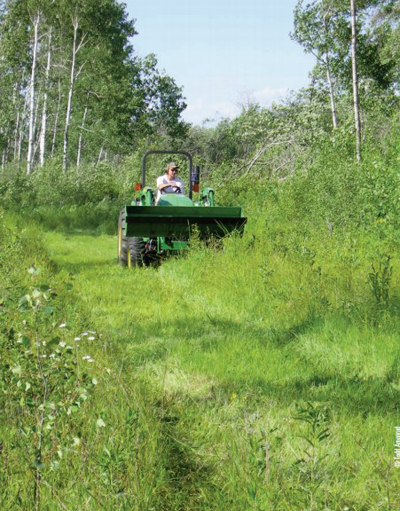
bush hog, you should make it as easy and quite to
approach your site as possible.
Planting a screen is something I highly recommend. Tall grasses are used most often for quick fixes. BioLogic’s Blind Spot is the best screening cover I’ve ever planted. It grows well in less than average soil; it’s simple to plant and will grow tall enough to conceal a human in only two months. When needing to walk through a food plot, oftentimes corn is an easy fix for a screen. Usually a 10 foot wide strip of corn will conceal most movement from the opposite side. If a more permanent fix is needed, native warm season grasses or conifer trees can be used.
Finally, the buddy system can work well, especially when you’re hunting the edge of a food source and you don’t have any cover to conceal your retreat after shooting hours. Whitetails can’t count, and most farm vehicles are much less intrusive than a hunter on foot. Obviously you need a friend for this, but when the friend drops you off and then leaves, the whitetails perceive that danger leaves with them. When they come back to pick you up, they bump the animals off of the food plot rather than educating the herd to your ambush location meaning danger.
Trick your gear, kill your deer.
Making sure that you prepare your ambush site with the proper equipment and then making sure that your gear is working properly and is in top condition will count when the moment of truth finally comes. Make sure you’re comfortable, prepared and alert.
You wouldn’t believe (or maybe you would) the amount of people that try to save $2.99 on a tree-step, a few bucks on a safety harness or $0.49 on a bolt. I’m all about saving money, but not if it means missing a chance at a mature buck. You should check your tree stands for squeaks and for possible safety issues. Make sure a sound isn’t going to happen at the wrong moment. Tighten the nuts and bolts, check the straps, seats and chains and lube any moving parts with powdered graphite, or some other type of lube with no odor (I haven’t found one yet).
Make sure you make it easy to climb the tree. You don’t want to make it to your tree silently, but then alert every animal for hundreds of yards around by scraping the bark completely off because you didn’t use enough tree steps or another climbing-stick section. Make it as effortless as possible. Make sure you’re comfortable in your tree stand. This is one reason why the older I get, the more I favor two-person ladder stands or ground blinds. I can sit all day in comfort in either. Sure, the two-person ladder stand makes it easy to bring one of my daughters with me, but it also makes it extra roomy and comfortable when I hunt it by myself.
Comfort also means that you have an easily accessible spot for your gun or bow. Here again, you wouldn’t believe how many people use the excuse, “I hold my bow (or gun) so it’s always ready,” when in reality, they’re just too cheap to buy a bow holder. You can stay so much more comfortable, warm, rested and still if you use a bow holder (or gun), and just as speedy as if you were holding it. It’s just so much more efficient and safe.
Snatch the pebble from my hand “Grasshopper.”
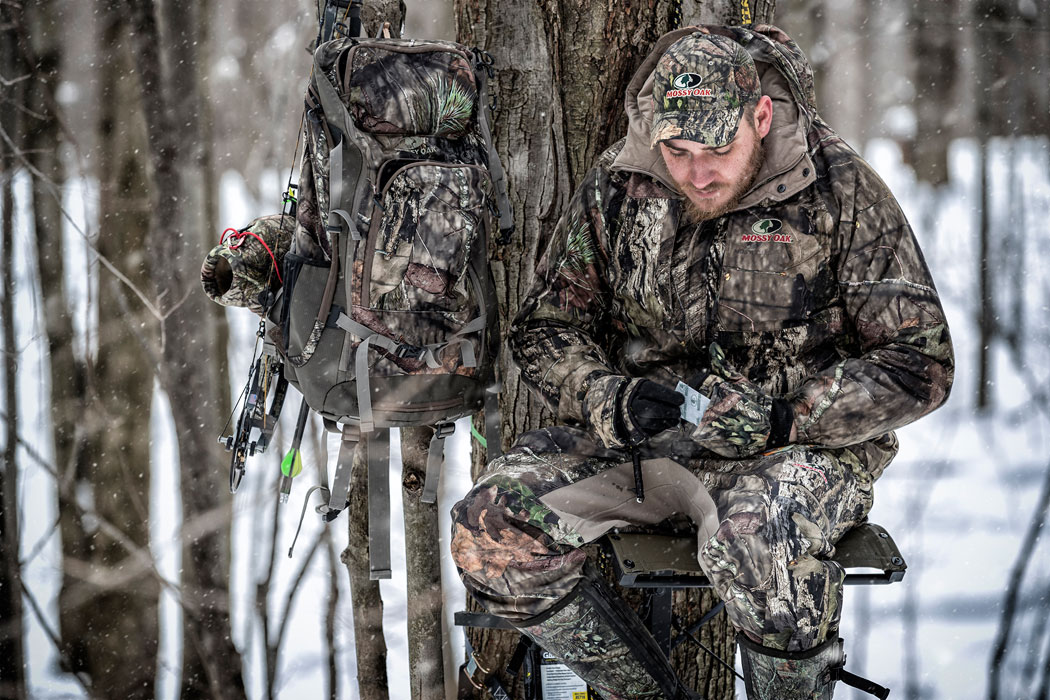
Last, but not least, attempt to exercise “perfect practice.” I call it this because it means practicing realistic hunting situations—during the same conditions, wearing the same clothing, using the same equipment and from the same type of ambush site/structure. If you’re going to hunt from a tree stand, practice from a tree stand (the same goes for a ground blind). Many who hunt from a ground blind fail to ever practice while kneeling or sitting - the position you will almost certainly be in during the moment of truth. 3D targets help dearly to learn angles. As most archers know, big game animals die primarily from “blood loss,” and where an arrow enters isn’t always as important as the exit hole concerning blood loss and recovery.
Clothing is one area many bowhunters have an issue with sometime during their career, especially while hunting during late season. Bulky cold-weather clothing can make it more difficult to draw your bow. Do you practice with the same facemask, you’ll be wearing afield? All of these questions should be answered BEFORE you attempt to go after your prey.
Practice with the same bow, arrows and hunting heads you’ll be using in the field (this also means practicing with the same gun, load and bullet size you’ll use during the hunt). Some broadhead manufacturers say they “fly like a field-point.” Most DO NOT! But still if they do “fly” like a field point, they are likely to impact your target in a different spot. Even if they do hit the same spot, isn’t this something you would like to know BEFORE you draw back on that buck of a lifetime?















